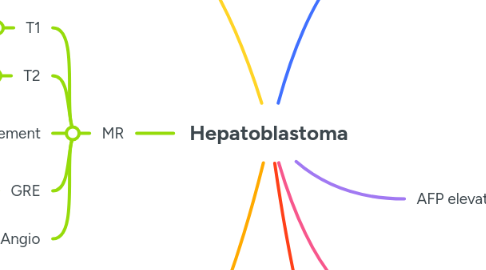Hepatoblastoma
da Devyani Bhatt


1. MR
1.1. T1
1.1.1. hypo
1.2. T2
1.2.1. hyper
1.3. enhancement
1.3.1. septae will enhance (hypo otherwise)
1.4. GRE
1.4.1. vascular invasion
1.5. Angio
1.5.1. pre-op
2. Demographics
2.1. most common hepatic neoplasm in kids
2.1.1. 90% diagnosed < 5 years
2.2. slightly M >F
2.3. Risk factors
2.3.1. prematurity
2.3.2. ITU exposure
2.3.2.1. oxygen
2.3.2.2. ventilation
2.3.2.3. furosemide
2.4. assoc syndromes
2.4.1. Beckwith Weidemann
2.4.2. FAP
2.4.2.1. Gardners
2.4.3. Trisomy 18
3. AFP elevated
4. Features
4.1. lobulated
4.2. homogenous/heterogenous if mixed
4.3. can invade portal/hepatic veins
5. Tx and Prognosis
5.1. many are unresectable at diagnosis
5.1.1. use chemo to shrink them first
5.2. pulmonary mets is not necessarily a contraindication
5.2.1. responds well to chemo
5.2.2. and ablation
6. USS
6.1. hyperechoic to ajdacent liver
6.2. mixed type
6.2.1. heterogenous appearance with anechoic areas
6.2.1.1. haemorrhage
6.2.1.2. necrosis
6.2.2. hypoechoic septa
7. CT
7.1. sharply circumcised mass
7.2. hypoattenuating to surrounding liver
7.2.1. enhances mildly but less than normal liver
7.2.1.1. peripheral on arterial phase
7.3. mixed type
7.3.1. speckled calcifications
